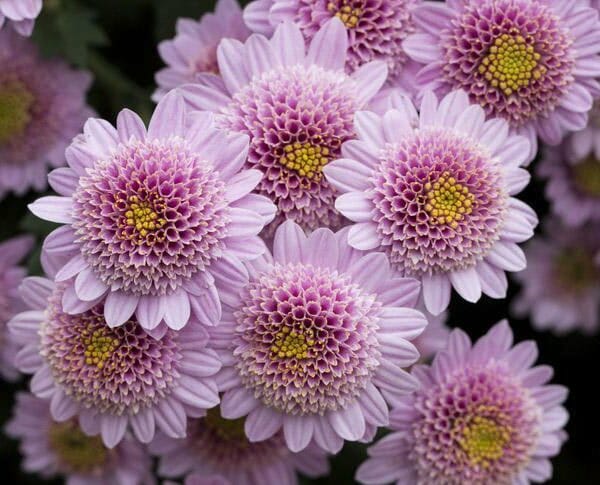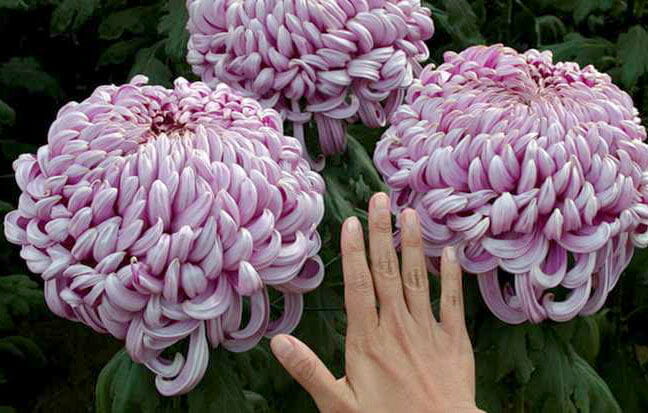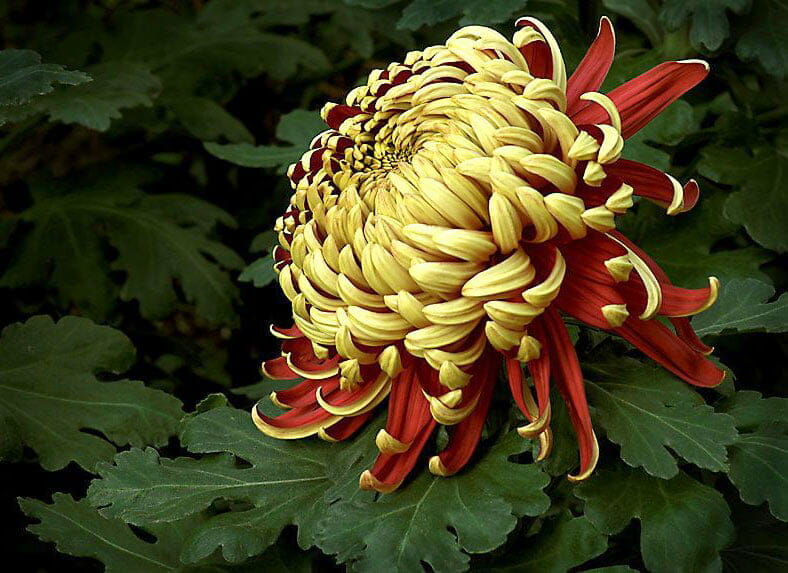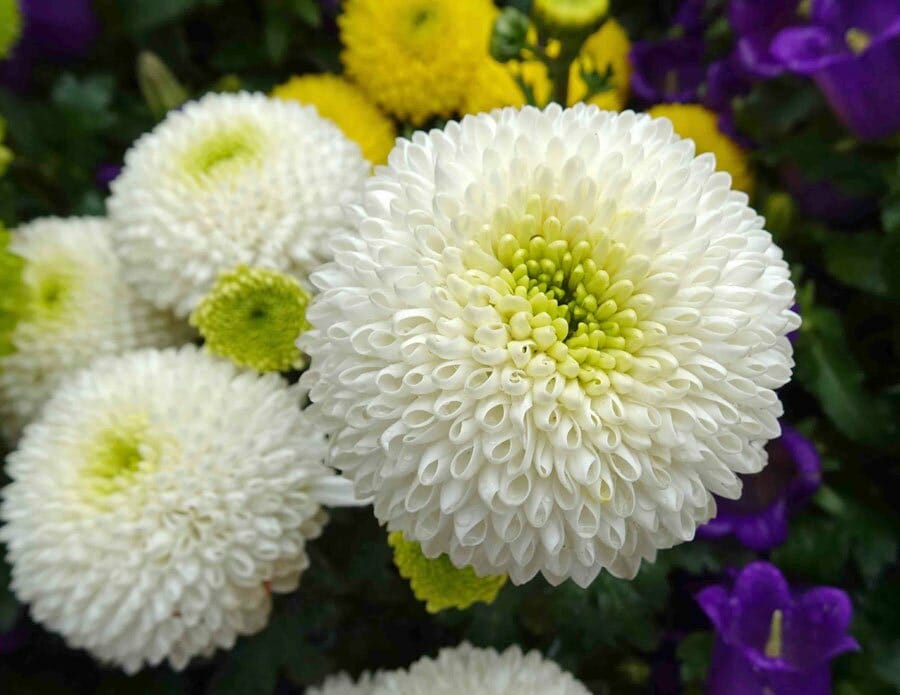The chrysanthemum has been very properly designated the queen of autumn flowers. Thanks to the untiring and assiduous efforts of the great growers and hybridizers it has been brought to a pitch of perfection undreamt of a generation ago.
The word Chrysanthemum has been derived from the Greek chrysos, gold, and anthemon, flower.
It is very interesting to see just how many plants are really Chrysanthemums. The wild Ox-Eye Daisy, the Shasta Daisy, the Pyrethrum (from which insect powder is made), the Feverfew of our grandmother’s garden, the Marguerite or Paris Daisy of the florist, as well as the monster decorative blooms of the expert culturist indoors, are all Chrysanthemums.

Some of the Chrysanthemums, or ‘Mums, as the gardener affectionately calls them, are annuals.
In the case of most of the annual species, the blooms resemble huge Daisies. They are white or some shade of yellow, and often, as hi the case of Chrysanthemum carinatum, they have a maroon or red ring of color at the center. The annual types can all be sown in April, in the open ground, where they should be thinned to eight inches, or, if large plants are wanted, pinch them back when .several leaves tall, and place them twelve inches apart. A rich, sandy loam suits them best and they surely love the sun.
They bloom profusely throughout the Summer and early Fall.
The species known as Golden Feather (Chrysanthemum praealtum var. aureum) should be sown indoors in Marclvand though really a perennial, it is treated as an annual. It is used as a yellow border plant. An excellent characteristic of some perennial Chrysanthemums is that they reproduce themselves so nicely by the production of suckers or underground stems. One of the species which multiplies itself in this manner is the Feverfew (Chrysanthemum Parthenium). It is a very old plant, but it certainly bears an interesting little tufted white and yellow flower in clusters which, coming in June, is well worthy of a place in the garden. It self-sows its seed, but rarely becomes a nuisance.
Hardy Chrysanthemums
The class is known as the hardy Chrysanthemums and which resemble the indoor varieties are of two types, the button-like or pompons, and the Aster-like or large-flowering varieties. Most of the varieties are hardy if protected in the Winter by dry leaves. They enjoy constant cultivation and rich soil that has been deeply prepared. They are best planted in the Spring and advice is frequently given that all old plants should be divided up and reset each year, for they exhaust the soil.
So multifarious are the varieties now at the disposal of the amateur gardener that it is possible to have it in bloom in the outdoor garden from August to November, and thence by the aid of glass to maintain the late flowering kinds in the height of their gorgeous beauty until February.
Main Types of Chrysanthemums
I have suggested that the chrysanthemum takes many forms, and it may be desirable for the guidance of the beginner to set out concisely the distinguishing features of the various types.
The Japanese Chrysanthemums
This variety predominates in the show and exhibition classes. The flowers are of great size, many are quaint and curious in shape, and they are notable for their rich coloring. The petals are broad and flat, but they turn and twist in all directions so much so, indeed, that it is difficult to distinguish them from the true incurved variety.

The Incurved Chrysanthemums
The flowers are more formal in their outline and build than the Japanese. The petals turn inwards and form a cone-shaped flower. THE REFLEXED. In contradistinction to those of the incurved class, the petals turn outwards from the center. This variety is not now as popular as it once was, but it still produces many splendid flowers.

Anemone-Flowered Chrysanthemums
These chrysanthemums have a cushion-like disc of quilled petals in the centre, and a fringe of long tasselled florets. They form a very pretty section for decorative purposes.

Pompon Chrysanthemums
Here the flowers are small and globular in shape. There are both single and double varieties, and they are among the earliest chrysanthemums to bloom. The pompons make a dainty section which should be represented in every amateur’s collection.

The Single Chrysanthemums
Generally early flowering, and suitable for placing in the border. They possess one or two circles of broad petals and cany a hard button or eye in the center.
Chrysanthemum Culture
The whole art of successful chrysanthemum culture consists in affording the plants a long season of growth. For eleven of the twelve months of the year, the Autumn Queen demands the assiduous attention of the cultivator. No sooner do one season’s flowers go out of bloom than he begins to busy himself in making preparations for the propagation of the plants which a year hence are to fill his greenhouse or conservatory with a gorgeous array of massive flowers of brilliant color.
The month of December is the real beginning of the chrysanthemum grower’s year, and it is then that he sets about the task of propagation. This applies solely to those growers who are able to afford both their old plants and their young cuttings some protection, either in a greenhouse or in a frost-proof frame, from the rigors of severe weather. The propagation of outdoor chrysanthemums may be deferred until spring is at hand.
Chrysanthemum Cuttings
What then should be the procedure to be followed in order to ensure a good supply of cuttings ? The process is simplicity itself. So soon as the last blooms have been removed from the old plants the stems should be cut down to within four inches of the base.
The pots may then be placed either in a slightly heated frame or in the coolest quarter of the glasshouse. Here, if they be given a moderate supply of moisture, they will speedily begin to throw up sturdy young shoots from the base of the plant. These are the shoots from which cuttings are to be taken, and it will be essential to keep them from becoming thin, drawn and weakly. This is the reason for removing them from the influence of excessive heat.
The process of shoot formation may be slow or rapid, according to the nature of each particular variety ; but, if it be slow, there is no necessity for impatience. In due time the shoots will begin to thrust themselves through the surface of the soil, without resort to forcing. If the old stool be examined at this period it will probably be found that while much of the new growth comes from the base of the plant other shoots thrust themselves out from the old stem.
These in many cases bear flower-buds at the extremity, and for all practical purposes they may be regarded as utterly useless. They can be ” struck,” but they will never produce satisfactory flowers. Therefore in taking cuttings the cultivator must devote his attention to encouraging the production of basal shoots which thrust themselves through the soil at some distance from the old stem.
If the old pots can be kept in a temperature of not less than 40 to 45 they will soon provide plenty of cuttings, and this process will be assisted if the surface soil in the pots be kept free from weeds and if some light sandy soil be spread over it.
How is it possible, it may be asked, to tell a good from a bad cutting ?
Taking cuttings from the stem of an old plant, and though it seems from all outward appearance to bear promise of future satisfactory growth, the promise is illusory. For even though no flower-bud appear at the apex of the shoot, it is probably there in embryo, and will very soon make its presence apparent. This is the kind of shoot to be discarded without remorse.
Cuttings taken from a shoot that emerged through the soil at some distance from the stem. In taking a cutting of this kind it is a good plan carefully to remove the surface soil to a depth of a few inches and to detach the cutting beneath the soil. This can easily be done if a sharp knife is used.
The next process is to trim the cutting by the removal of three or four of the leaves towards its base. This should not be done by pulling the leaves from the stem with the thumb and finger and employing such force that part of the fleshy portion of the stem is torn away. The safer plan is to cut off the lower leaves as near the stem as possible, either with a pair of sharp scissors or with a knife. The ideal cutting should be three inches in length, and it may be reduced to this size by cutting horizontally (not slantwise) immediately beneath a joint formed by the union of the leaf stalks to the stem of the cutting.
The preparation of the soil for the reception of the cuttings is an important item at this stage of the proceedings. The most satisfactory compost will be obtained if fibrous loam and thoroughly decomposed leaf mould be well mixed together in equal proportions. To this it will be necessary to add a good quantity of coarse silver sand. When this has been incorporated the whole compost should be passed through a half-inch sieve. The soil ought to be nicely moist but not so wet as to be sticky and difficult to manipulate.
Next it must be decided where the cuttings are to be ” struck,” whether in pots or boxes. In the case of the choicer Japanese varieties I have no hesitation in recommending the use of small pots. The chrysanthemum, above all things, requires uninterrupted growth, and there is danger if the cuttings are struck in boxes that when the tune comes for ” potting on ” the roots may be damaged, and growth be thereby checked. ” Thumb ” pots are quite large enough to receive the cuttings in the earliest stage of their development. They should be thoroughly washed before being brought into use, and in the case of new pots it is advisable to soak them for a few hours before use, otherwise they will withdraw a good deal of the moisture from the soil, and probably leave the stem of the cutting dry. This would considerably retard the process of root formation.
For drainage purposes one broken crock should be placed in the bottom of the pot. Over this it will be well to put in a small quantity of rougher soil from the sittings. Fill the pot nearly to the brim with the prepared compost, and make fairly firm.
Chrysanthemum Care
As soon as the plants have grown four inches tall, especially if few plants are available, and a good display is wished, they should be pinched. This will cause them to branch nicely, each shoot bearing a number of buds. From the very start of growth, the plants must be staked. The greatest fault with this group is that they all fall down near blooming time but the whole beauty of the plant is destroyed if the staking is neglected. The shoots can easily be tied to stakes if the stakes are once in place. If the very largest flowers rather than the greatest quantity of bloom are wanted, feed with liquid manure when buds begin to show, and remove many of the smaller buds on each stem. Chrysanthemum blooms will be much better if a covering is placed over them during the cold Fall rains or on the nights of frosts.






